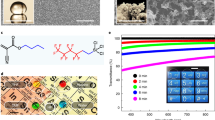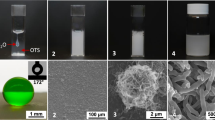Abstract
TECHNIQUES for surface modification are of considerable technological interest for the fabrication of water-repellent and anti-fouling coatings. Silanization1 (the chemical grafting of organic molecules onto a substrate via a trichlorosilane group) stands out among these techniques by virtue of its ability to provide highly compact coatings of optical quality, extreme chemical inertness and adjustable wettability2. Although the silanization reaction has been extensively characterized3–8, the properties of the grafted layers are still too variable for most commercial applications; for example, the quality of the grafted layers depends critically on the presence of trace amounts of water, and on the temperature at which the silanization reaction takes place9. Here we provide evidence for the existence of a near-ambient temperature threshold, Tc, which represents an upper bound for obtaining the highest-quality films. This threshold temperature is found to be an intrinsic property of the silane molecules: it depends linearly on their chain length, but is independent of the solvent used for the reaction. We suggest that Tc is analogous to the triple point in the phase diagram of Langmuir monolayers.
Similar content being viewed by others
References
Bigelow, W. C., Pickett, D. L. & Zisman, W. A. J. Colloid Sci. 1, 513 (1946).
Plueddeman, E. P., in Silane Coupling Agents (Plenum, New York, 1982).
Maoz, R. & Sagiv, J. J. Colloid. Interf. Sci. 100, 465 (1984).
Netzer, L., Iscovici, R. & Sagiv, J. Thin solid Films 100, 67 (1983).
Gun, J. & Sagiv, J. J. Colloid. Interf. Sci. 112, 457 (1986).
Tidswell, I. M. et al. J. chem. Phys. 95, 2854 (1991).
Tidswell, I. M. et al. phys. Rev. B41, 1111 (1990).
Wasserman, S. R., Tao, Y. T. & Whitesides, G. M. Langmuir 5, 1074 (1989).
Silberzan, P., Léger, L. Ausséré, D. & Bennattar, J. J. Langmuir 7(8), 1647 (1991).
Vig, J. R. J. Vac. Sci. technol. A3, 1027 (1985).
Kruger, A. A. in Surface and Near Surface Chemistry of Oxide Materials (eds Nowotny, J. & Dufour, L. C.) 413–448 (Elsevier, Amsterdam, 1985).
Zisman, W. A. Adv. Chem. Ser. No. 43, 1 (1964).
Gaines, G. L. in Insoluble Monolayers at Liquid-Gas Interfaces (Wiley, New York, 1966).
Kellner, B. M. J., Muller-Landau, F. & Cadenhead, D. A. J. Colloid. Interf. Sci. 66, 3 (1978).
Allain, C., Ausséré, D. & Rondelez, F. J. Colloid. Interf. Sci. 107, 5 (1985).
Dussan, V. E. J. Fluid Mech. 151, 1 (1985).
Brochard-Wyart, F., Hervet, H., Redon, C. & Rondelez, F. J. Colloid. Interf. Sci. 142, 518 (1991).
Author information
Authors and Affiliations
Rights and permissions
About this article
Cite this article
Brzoska, J., Shahidzadeh, N. & Rondelez, F. Evidence of a transition temperature for the optimum deposition of grafted monolayer coatings. Nature 360, 719–721 (1992). https://doi.org/10.1038/360719a0
Received:
Accepted:
Issue Date:
DOI: https://doi.org/10.1038/360719a0
- Springer Nature Limited
This article is cited by
-
Terminal silanization of perfluoropolyether, polydimethylsiloxane, their block polymer and the self-assembled films on plasma-treated silicon surfaces
Chemical Papers (2019)
-
Construction of grating structure model based on Gibbs free energy and experimental verification by micro-milling
Applied Physics A (2019)
-
From self-assembled monolayers to chemically patterned brushes: Controlling the orientation of block copolymer domains in films by substrate modification
Chinese Journal of Polymer Science (2016)
-
Self-assembled nanofilm of 1,2-dihydro-3-(octadecylthio)benzotriazine on copper for corrosion protection
Bulletin of Materials Science (2014)
-
Silicon Based Nanocoatings on Metal Alloys and Their Role in Surface Engineering
Silicon (2010)





